John-Rob Pool
Urban Biodiversity
Learn how cities can protect biodiversity and secure the benefits of healthy ecosystems for all residents. This course focuses on biodiversity strategy in the context of city priorities, constraints, and planning processes. It provides learners with tools they can use to integrate nature-supportive actions into wider urban practices.
Click to enroll in: English | Spanish | French | Portuguese | Bahasa Indonesia | Mandarin
Cities are ecosystems. And like all ecosystems, cities depend for their well-being on the countless living things that they comprise. Natural ecosystems within and near cities clean our air and water, moderate climatic extremes, supply the food and fiber that sustain our economies, and provide the beauty and recreational opportunities that help make our lives whole.
In this course, we examine biodiversity and strategies to protect it, but we do it through a specifically urban lens. We examine how biodiversity benefits cities’ human residents, and what cities can do to support biodiversity in the context of city priorities, constraints, and planning processes.
Learners completing this course will gain the knowledge and analytical tools necessary to:
- Integrate biodiversity protection in a larger urban planning context
- Evaluate designs for urban parks and water infrastructure based on their value as habitat
- Make the economic case for investment in biodiversity
- Build and implement a data strategy to support biodiversity protection in the long term
LEARNING OBJECTIVES
From this course, you will come away with an understanding of the complex and intricate biodiversity that exists within urban areas, and how cities can support it and work with it.
Biodiversity in CitiesUnderstand the importance of biodiversity to cities in terms of economic, environmental, and public health benefits. Describe methods for prioritizing species or ecosystems for protection and make the case for ecosystem protection even in the absence of detailed biological information. |
Habitat QualityUnderstand the roles that habitat size, connectivity, diversity and complexity play in supporting citywide and regional biodiversity. Recognize how these determinants of habitat quality manifest in urban design and planning. |
Valuation of NatureArticulate the benefits of biodiversity in terms of public health, economic well-being and civic life. Formulate strategies for quantifying and communicating these benefits to government and public stakeholders. |
DataUnderstand the principles of data strategy and indicator development; data acquisition, sharing, safety and governance; and interpretation and communication of data insights. |
- Duration
-
5 hours
- Institution
-
World Resources Institute
- Languages
-
English (French, Spanish, Portuguese, Bahasa Indonesia and Mandarin Chinese coming soon)
Course Outline
Section 1: Biodiversity in the Urban ContextWe explore why biodiversity is important to cities, and how cities can contribute to protecting biodiversity regionally and globally. We examine biodiversity through an urban lens and develop a specifically urban approach to protecting biodiversity and supporting healthy ecosystems. We also explore concepts useful to the prioritization of species for conservation while motivating a species-agnostic, whole-ecosystem approach. |
Section 2: Habitat FunctionsWe examine the traditional concept of habitat, discuss how habitat functions to support healthy populations of living things, and develop a habitat concept designed to inform urban practitioners who lack high-quality biological information on local biodiversity. |
Section 3: Determinants of Habitat QualityArticulate the benefits of biodiversity in terms of public health, economic well-being and civic life. Formulate strategies for quantifying and communicating these benefits to government and public stakeholders.
|
Section 4: Valuation of EcosystemsWe explore strategies for quantifying the value of biodiversity and green spaces in terms of public health, economic well-being, and improvements to civic life. We examine case studies of green space valuation and develop a general framework for data-informed valuation. |
Section 5: Data Strategy for Urban BiodiversityWe develop general concepts for using data in urban biodiversity strategy, focusing in depth on the Singapore Index on Cities’ Biodiversity. We explore indicator development, data research, data sharing and acquisition, data safety and governance, data interpretation, and communication of data insights. |
Course Authors
REVIEWERS & COLLABORATORS
- Cynnamon Dobbs, Assistant Professor, University of Connecticut
- Lisa Beyer, Urban Water Infrastructure Manager, World Resources Institute
- Mariana Orloff, Associate II, World Resources Institute
- Robin King, Director of Knowledge Capture and Collaboration, World Resources Institute
- Catyana Falsetti, Learning and Knowledge Manager, World Resources Institute
- Christopher Gillespie, Project Specialist & Research Coordinator, World Resources Institute
- Olga Horn, Senior Officer, Nature-based Solutions & Biodiversity, ICLEI
- Ingrid Coetzee, Director, Biodiversity, Nature & Health, ICLEI





